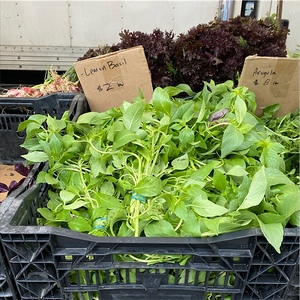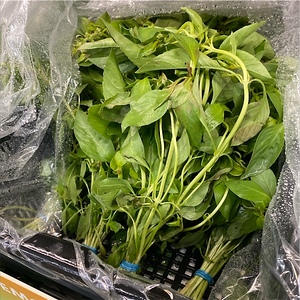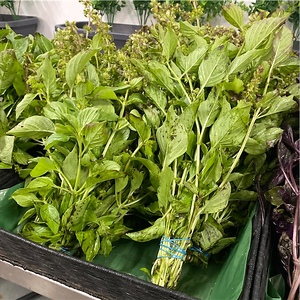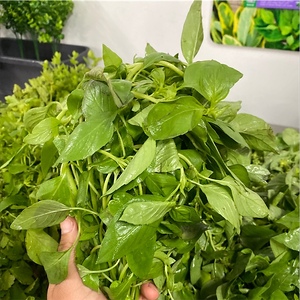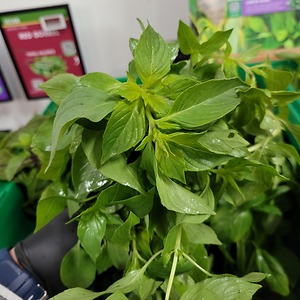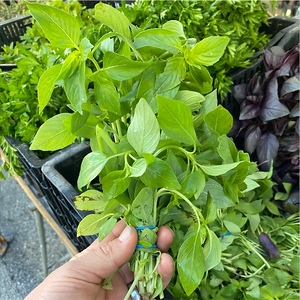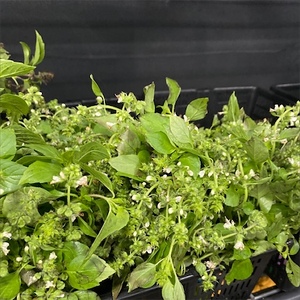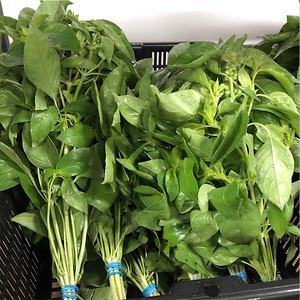


Lemon Basil
Estimated Inventory, lb : 0
Description/Taste
Lemon basil leaves are small to medium in size, averaging five centimeters in length, and have an elliptical to elongated, oval shape tapering to a distinct point on the non-stem end. The leaves are smooth, flat, and green, containing some veining across the surface with lightly serrated edges. The leaves also grow in pairs on either side of the square, fuzzy stalks, and have a crisp and succulent consistency with a sweet, citrus-forward aroma. Lemon basil has a unique herbal, sweet, and tangy flavor with notes of lemon mixed with anise. In the late summer, the plants also produce lemon-scented, small white flowers that bloom on long, light green bracts.
Seasons/Availability
Lemon basil is available year-round, with a peak season in the summer.
Current Facts
Lemon basil, botanically classified as Ocimum X citriodorum, is a hybrid variety belonging to the Lamiaceae or mint family. The annual plant grows up to 50 centimeters in height and is known for its refreshing and subtly sweet citrus fragrance. Lemon basil is native to Asia, also known as Kemangi in Indonesia, Maenglak in Thailand, and Nasi Ulam in Malaysia, and has remained primarily localized to these regions, used as a fresh, edible garnish. Many Southeast Asian communities harvest the herb straight from wild plants, incorporating the leaves as a flavoring in soups, appetizers, and main dishes. Outside of Asia, Lemon basil is grown as a specialty cultivar in home gardens throughout the United States. The variety is favored as a flavorful addition to edible landscapes, and some farms also grow the cultivar for sale at local farmer’s markets.
Nutritional Value
Lemon basil is an excellent source of beta-carotene, a pigment that is converted into vitamin A in the body to protect against vision loss. The greens are also a good source of vitamin K to assist in faster wound healing and provide some magnesium, iron, manganese, copper, calcium, and vitamin C. In addition to vitamins and minerals, Lemon basil contains the compounds limonene and citral, contributing to the herb’s citrus-like flavor and supplying some anti-inflammatory properties.
Applications
Lemon basil is best suited as a finishing element and can be utilized in both raw and cooked applications. It is important to note that Lemon basil should be added just before plating to maintain the herb’s flavor and aromatic qualities. The leaves can be lightly torn and tossed into green salads, minced into dips and vinaigrettes, or stirred into beverages, including cocktails, iced tea, and lemonade. Lemon basil can also be rubbed over meats to impart a subtle flavoring, mixed into rice, pasta, and noodle bowls, or thinly sliced and served over fresh peaches as a bright appetizer. In addition to fresh applications, Lemon basil can be infused into oils or syrups and incorporated into jams, crumbles, cobblers, ice cream, and puddings. Lemon basil will also add a citrusy, anise flavor to cookies, scones, or other baked goods. In some regions of Southeast Asia, the white flowers are eaten in combination with the leaves, tossed into salads, soups, and slaws. Lemon basil pairs well with aromatics such as ginger, garlic, chives, and mint, coconut milk, meats such as poultry, beef, and turkey, seafood, cheeses such as goat, mozzarella, parmesan, and blue, and vegetables such as zucchini, green beans, and asparagus. Lemon basil is highly perishable, losing flavor after a couple of days, and will keep up to three days when loosely wrapped and stored in the refrigerator. If the leaves are still attached to their stems, they can be placed in a glass of water, covered with a plastic bag, and refrigerated.
Ethnic/Cultural Info
Lemon basil is the primary variety of basil used in Laos cuisine, known as Pak I Tou Lao, and is prized for its delicate citrus scent. Laos, also known as the Lao People’s Democratic Republic, is a relatively small country in Asia, found between Vietnam, Thailand, Cambodia, Myanmar, and China. The landlocked county has a slow commercial transport system, resulting in the population to rely heavily on plants and animals that live along rivers as a source of food. Many Laotians also rely on locally available, foraged ingredients, including Lemon basil, and grow many different types of plants in home gardens for daily cooking. Laotians prefer to use herbs such as Lemon basil fresh, and the greens are either served as a cooling accompaniment to spicy dishes, or they are added at the end of cooked preparations to impart a tangy, bright, and herbal taste. Despite being mostly unknown globally, Laos cuisine comprises complex flavorings, and Lemon basil is traditionally mixed into soups, stews, and grilled meats. One of the most popular stews, known as or lam, is a subtly spicy mixture of lemongrass, meat, chile peppers, mushrooms, eggplant, and bitter greens. Once the stew is prepared, it is finished with dill and Lemon basil as a fragrant, edible garnish. Or lam can be prepared as an everyday meal, but it is also served during new year’s celebrations as a festive dish at family gatherings.
Geography/History
Lemon basil is believed to be native to India and has been growing wild since ancient times. The herb was spread across Asia in the early ages and became extensively cultivated in Southeast Asia for its delicate, herbal flavor. While the exact origins of the variety are unknown, experts believe the cultivar is a hybrid between American basil, Ocimum americanum, and sweet basil, Ocimum basilicum. Lemon basil was brought to the Americas sometime during the 17th century, but the variety was never commercially grown, limiting the basil to specialty growers and home gardens. Today Lemon basil is primarily found in Southeast Asia, Asia, and Indonesia, but it can be spotted at farmer’s markets, Asian markets, and local grocers in temperate regions of the United States. Lemon basil is also found in seed form through online retailers as the variety can easily be grown from seed in home gardens.
Recipe Ideas
Recipes that include Lemon Basil. One



